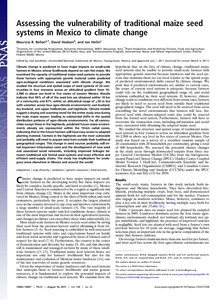Focal point
Location
The Food and Agriculture Organization of the United Nations leads international efforts to defeat hunger. Serving both developed and developing countries, FAO acts as a neutral forum where all nations meet as equals to negotiate agreements and debate policy. FAO is also a source of knowledge and information. We help developing countries and countries in transition modernize and improve agriculture, forestry and fisheries practices and ensure good nutrition for all. Since our founding in 1945, we have focused special attention on developing rural areas, home to 70 percent of the world's poor and hungry people.
Members:
Resources
Displaying 2516 - 2520 of 5074Assessing the vulnerability of traditional maize seed systems in Mexico to climate change
Climate change is predicted to have major impacts on small-scale farmers in Mexico whose livelihoods depend on rain-fed maize. We examined the capacity of traditional maize seed systems to provide these farmers with appropriate genetic material under predicted agro-ecological conditions associated with climate change. We studied the structure and spatial scope of seed systems of 20 communities in four transects across an altitudinal gradient from 10–2,980 m above sea level in five states of eastern Mexico.
Las mujeres en la agricultura. Cerrar la brecha de género en aras del desarrollo
La agricultura tiene un bajo rendimiento en muchos países en desarrollo por varias razones. Entre ellas está el hecho de que las mujeres carecen de los recursos y oportunidades que necesitan para rentabilizar al máximo el uso de su tiempo. Las mujeres son agricultoras, trabajadoras y empresarias, pero en casi todas partes tienen dificultades más graves que los hombres para acceder a los recursos productivos, los mercados y los servicios.
Cerrar la brecha entre hombres y mujeres en la agricultura
El mundo no puede eliminar el hambre sin cerrar la brecha que existe en la agricultura entre hombres y mujeres. Con igual acceso a recursos productivos y servicios como tierra, agua y crédito, las mujeres agricultoras pueden producir entre un 20 y 30 por ciento más de alimentos, suficientes para sacar del hambre a 150 millones de personas.
International cooperation for sustainable land and water management
Cambodia and FAO Achievements and success stories
Today, over 80 percent of the population of Cambodia lives in rural areas and about 73 percent depends on agriculture for their livelihoods. However, only about 20 percent of the land is arable. Cambodia became a member of FAO in 1950, and an FAO Representative office was opened in 1995.











